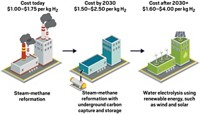Advertisement
Grab your lab coat. Let's get started
Welcome!
Welcome!
Create an account below to get 6 C&EN articles per month, receive newsletters and more - all free.
It seems this is your first time logging in online. Please enter the following information to continue.
As an ACS member you automatically get access to this site. All we need is few more details to create your reading experience.
Not you? Sign in with a different account.
Not you? Sign in with a different account.
ERROR 1
ERROR 1
ERROR 2
ERROR 2
ERROR 2
ERROR 2
ERROR 2
Password and Confirm password must match.
If you have an ACS member number, please enter it here so we can link this account to your membership. (optional)
ERROR 2
ACS values your privacy. By submitting your information, you are gaining access to C&EN and subscribing to our weekly newsletter. We use the information you provide to make your reading experience better, and we will never sell your data to third party members.
Environment
Manure Could Provide U.S. Power
Energy Policy: Clean power from livestock waste would become economical with carbon tax
by Christopher Pala
July 21, 2011

Taxing greenhouse gas emissions would allow manure to compete economically with fossil fuels and to produce 5.5% of U.S. electricity needs by 2050, according to a new analysis (Environ. Sci. Technol., DOI: 10.1021/es104227y).
Today, a tiny fraction of the manure from the nation’s 2.2 million cattle, pigs, and chickens is fed into power plants called anaerobic digesters. Bacteria in the digesters break down the waste to produce methane, which the plants burn to generate electricity. There are about 150 anaerobic digesters in the U.S., which produce power at about double the average cost of energy from fossil fuels.
David P.M. Zaks of the University of Wisconsin, Madison, and his colleagues wanted to know whether power from anaerobic digesters became more economically viable under different energy policies. Using data from anaerobic digesters such as their capital costs, costs of hauling manure to the plants, and their emissions savings, the researchers employed the MIT Emissions Prediction and Policy Analysis model, a well-known computer simulation of the world economy.
They found that a climate policy similar to the so-called “cap and trade” one that Congress considered but failed to pass, says Zaks, would have made power from anaerobic digesters profitable in replacing 5.5% of the country’s energy needs. In the policy, a nationwide limit on emissions would make energy from fossil fuels progressively more expensive, peaking in 2050 at $316 per ton of carbon dioxide.
In addition to replacing fossil fuels, the digesters would provide the benefit of reducing methane release from manure, Zaks says. The http://www.epa.gov/climatechange/emissions/usinventoryreport.html that the methane from livestock manure currently makes up 0.8% of the country’s greenhouse gases. If digesters produced 5.5% of U.S. electricity, the researchers found, they would also reduce emissions from livestock by the equivalent of 151 million metric tons of CO2.



Join the conversation
Contact the reporter
Submit a Letter to the Editor for publication
Engage with us on Twitter